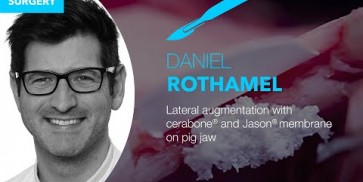
Jason® membrane
- Horizontal and vertical augmentation
- Ridge reconstruction
- Socket and ridge preservation
- Sinus lift
- Protection and covering of Schneiderian membrane
- Fenestration and dehiscence defects
- Intrabony defects (1- 3 wall)
- Furcation defects (class I and II)
|
- Long-lasting barrier function
- Low-thickness native structure
- Easy manipulation, can be applied dry or wet
- No stickiness after rehydration
- Fast vascularization due to three-dimensional structure
- Multi-directional strength and tear resistance
Art.-No. | Size | Content | ||
|---|---|---|---|---|
681520 | 15x20 mm | 1 x membrane | ||
682030 | 20x30 mm | 1 x membrane | ||
683040 | 30x40 mm | 1 x membrane | ||

Due to the unique production process, the superior properties of the native pericardium are preserved during the extensive cleaning procedure that is applied for the production of Jason® membrane. Therefore, Jason® membrane shows a natural honeycomb-like, multilayered collagen structure with an increased content of collagen type III leading to a remarkable tear resistance to and a slow degradation of Jason® membrane. This ensures a natural long barrier function, making the Jason® membrane our recommended choice particularly for large augmentative procedures. The low thickness of 0.05 - 0.35 mm facilitates the soft tissue management specifically in patients with a thin gingival biotype. The membrane can be applied dry and wet, cut to shape, is not sticky after rehydration and its tear resistance allows for fixation by pins or sutures.
Please find our free webinars at www.botiss-webinars.com
Kostenfreie Webinare zu Schulungszwecken finden Sie unter www.botiss-webinars.com
Please find our free webinars at www.botiss-webinars.com
Please find our free webinars at www.botiss-webinars.com
Please find our free webinars at www.botiss-webinars.com
Please find our free webinars at www.botiss-webinars.com
Please find our free webinars at www.botiss-webinars.com
Please Contact us for Literature.





































































































